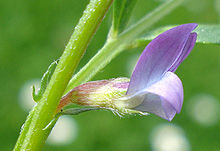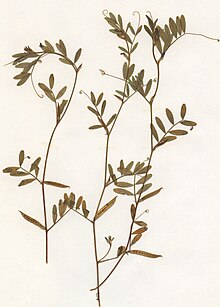Sweet pea vetch
| Sweet pea vetch | ||||||||||||
|---|---|---|---|---|---|---|---|---|---|---|---|---|

Sweet pea vetch ( Vicia lathyroides ) |
||||||||||||
| Systematics | ||||||||||||
|
||||||||||||
| Scientific name | ||||||||||||
| Vicia lathyroides | ||||||||||||
| L. |
The Vicia Lathyroides ( Vicia lathyroides ), also Spring dwarf Wicke , sand-changing or Kicher Vetch called, is a plant of the genus vetch ( Vicia ) in the subfamily of Schmetterlingsblütler (Faboideae) within the family of the Leguminosae (Fabaceae) . It is widespread from Europe to Asia Minor and North Africa.
description
Vegetative characteristics
The flat pea vetch is an annual or more often wintering annual herbaceous plant . It forms a weak root and several stems. The prostrate or ascending stem is short and soft (almost silky) hairy or bald, relatively thin, 5 to 15 cm long and only branched at the base.
The pinnate leaves are about 1 to 3 cm long and covered with a short spindle, usually only with an awn, more rarely with a simple tendril. The leaves have one or two pairs of bald or short hairy leaflets. The lower ones are obovate to inverted heart-shaped, about 2 to 6 mm long and about half as wide, the upper ones are up to 14 mm long, elliptical to linear, truncated to pointed and have acutely angled lateral nerves. The stipules are relatively small, half-arrow-shaped, with entire margins and without nectaries .
Generative characteristics
The flowering period extends mainly from April to June, it often blooms again in August. The almost sessile flowers usually sit individually in the leaf axils. The hermaphrodite flowers are zygomorphic at a height of 5 to 8 millimeters and five-fold with a double flower envelope . The calyx is funnel-shaped-bell-shaped and more or less hairy. The calyx teeth are lanceolate and about as long as the calyx tube. The crown is usually light purple, rarely white. The flag is inverted-heart-shaped, folded and hardly longer than the wings. The more bluish wings are about twice as long as the boat. The blunt boat is greenish and dark purple at the tip. All ten stamens are fused.
Vicia lathyroides is the grass pea ( Lathyrus close) because all filaments are fused. There are no honey holes and nectar does not seem to be secreted either. The stylus is noticeably short, but has a well-developed stylus brush at the front. The pollination facility is thus greatly reduced compared to that of most other vetches, due to autogamy .
The more or less protruding legumes are linear, beaked, slightly puffy, smooth, mostly bare, brown to black and contain about seven seeds, with a length of 2 to 2.5 centimeters and a width of about 4 millimeters.
The seeds are rounded-prismatic, about 1.5 to 2 mm long, clearly warty and reddish brown to black in color. The flat pea vetch is the only European vetch with warty seeds.
The number of chromosomes is 2n = 12.
Occurrence
Vicia lathyroides is a sub-Mediterranean-subatlantic floral element . The flat pea vetch is found scattered all over Europe as far as southern Scandinavia , the Caucasus , the Crimea , Asia Minor and North Africa . The main area of the flat pea vetch is in Western Europe and in the Mediterranean area . It is absent in large areas on the Iberian Peninsula and in the higher parts of Central Europe.
In Central Europe it occurs on the West, East and North Frisian Islands, in Schleswig-Holstein , Mecklenburg-Western Pomerania ; It is rare in Brandenburg , in the sandy areas from the Lower Rhine to the Palatinate as well as on the Main , in the Rhine - Neckar area and on the lower reaches of the Regen , at the foot of the Alps , in Styria , in Carinthia , in Burgenland and in Lower Austria . In Germany, the sweet pea vetch is often only found in northern and eastern Germany , in Bavaria in the Main and Regnitz areas only rarely.
The sweet pea vetch thrives in short grasslands and heather , on pastures , sandy fallow fields and on roadsides. In Germany it thrives almost exclusively in the lowlands and in the colline highlands .
The sweet pea vetch thrives best on sandy, lime-poor, slightly acidic sandy soils that can be poor in humus and fine soil , but should be warm in summer. In Central Europe it is a character species of the order of the Corynephoretalia canescentis societies, the societies rich in silver grass, but also occurs in societies of the Sedo-Scleranthetalia order.
literature
- Gustav Hegi, H. Gams, H. Marzell: Illustrated flora of Central Europe. Pteridophyta, Spermatophyta . 2nd Edition. Volume IV. Part 3: Angiospermae: Dicotyledones 2 (5) (Leguminosae - Tropaeolaceae) . Carl Hanser and Paul Parey, Munich and Berlin / Hamburg 1964, ISBN 3-489-70020-1 (unchanged reprint from 1923-1924 with addendum).
- Konrad von Weihe (ed.): Illustrated flora. Germany and neighboring areas. Vascular cryptogams and flowering plants . Founded by August Garcke. 23rd edition. Paul Parey, Berlin / Hamburg 1972, ISBN 3-489-68034-0 .
- Oskar Sebald, Siegmund Seybold, Georg Philippi (Hrsg.): The fern and flowering plants of Baden-Württemberg . 2nd expanded edition. tape 2 : Special part (Spermatophyta, subclass Dilleniidae): Hypericaceae to Primulaceae . Eugen Ulmer, Stuttgart (Hohenheim) 1993, ISBN 3-8001-3323-7 .
- Wolfgang Adler, Karl Oswald, Raimund Fischer: Excursion flora of Austria . Ed .: Manfred A. Fischer. Eugen Ulmer, Stuttgart / Vienna 1994, ISBN 3-8001-3461-6 .
- Christian Heitz: School and excursion flora for Switzerland. Taking into account the border areas. Identification book for wild growing vascular plants . Founded by August Binz. 18th completely revised and expanded edition. Schwabe & Co., Basel 1986, ISBN 3-7965-0832-4 .
- Erich Oberdorfer : Plant-sociological excursion flora . With the collaboration of Theo Müller. 6th, revised and expanded edition. Eugen Ulmer, Stuttgart (Hohenheim) 1990, ISBN 3-8001-3454-3 .
Individual evidence
- ↑ Vicia lathyroides L., flat pea vetch. In: FloraWeb.de.
- ↑ a b Erich Oberdorfer : Plant-sociological excursion flora for Germany and neighboring areas . 8th edition. Verlag Eugen Ulmer, Stuttgart 2001, ISBN 3-8001-3131-5 . Page 613.
- ↑ a b c Dietmar Aichele, Heinz-Werner Schwegler: The flowering plants of Central Europe . 2nd Edition. tape 2 : Yew family to butterfly family . Franckh-Kosmos, Stuttgart 2000, ISBN 3-440-08048-X .
Web links
- Sweet pea vetch. In: FloraWeb.de.
- Sweet pea vetch . In: BiolFlor, the database of biological-ecological characteristics of the flora of Germany.
- Profile and distribution map for Bavaria . In: Botanical Information Hub of Bavaria .
- Vicia lathyroides L. In: Info Flora , the national data and information center for Swiss flora . Retrieved November 22, 2015.
- Distribution in the northern hemisphere according to Eric Hultén
- Thomas Meyer: Data sheet with identification key and photos at Flora-de: Flora von Deutschland (old name of the website: Flowers in Swabia )


